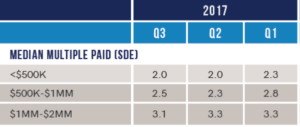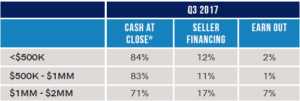Exit Strategies Advises on Management Buyout of Carpenter Crane Hoist
MARE ISLAND, California – Exit Strategies is pleased to have recently served as financial acquisition advisor in management’s carve-out of the Carpenter Crane Hoist division from The Carpenter Group (TCG). The buy-out (MBO) was led by executives Dane Oliver and Ben Jones with the support of an equity partner. The acquisition marks the beginning of an exciting era for Carpenter Crane Hoist (CCH) as management implements plans to expand offerings and operations to address the needs of a growing specialty crane market.

Since its forming in 1996 as the seventh division of The Carpenter Group, CCH has designed and produced overhead cranes for clean rooms and harsh environments. CCH uses proprietary components and materials and customizes every system to satisfy the unique application requirements of its clients. Electronic controls and custom holding fixtures are typical. CCH produces cranes to 25-ton capacity for up to class 10 clean room environments for top semiconductor companies and research facilities across the U.S. For more information see www.carpentercranehoist.com.
The Carpenter Group, with six locations, distributes rigging products to OEMs and end users throughout California and the West Coast in the construction and marine industries and other sectors. The carve-out of CCH made sense for TCG because the business unit was not core to its overall strategy. See www.carpenterrigging.com for more information.
How Exit Strategies Helped
Management contacted us on the advice of their attorney to determine if a buyout was feasible and to help put the deal on track. Exit Strategies’ role consisted of sizing up the situation, advising management on process and strategy with respect to the proposed carve-out, analyzing historical financials and helping develop projections, valuation calculations, finding a lender to preapprove financing, pitching the spin-off to The Carpenter Group, and working with management’s attorney to negotiate a favorable letter of intent. Umpqua Bank supported the deal with senior term debt. Deal terms are confidential.
About Us
Exit Strategies Group is a California-based M&A brokerage and business valuation firm. Founded in 2002, we mostly serve sellers in lower middle-market transactions, representing them from start to finish. Our seasoned brokers and advisors have over 100 years of combined deal making experience spanning many industries. In this instance we are very pleased to have facilitated a successful management buyout and spin-off that benefited all stakeholders.
To find out how Exit Strategies can help you complete a successful business sale, spin-off, merger or acquisition, contact President Al Statz at 707-781-8580, alstatz@exitstrategiesgroup.com.

 SBA 7(a) loans are a popular type of financing for small business acquisitions. These loans go up to $5,000,000 and can be used to buy a business, real estate or equipment. Several changes to the SBA 7(a) program became effective in 2018 that are worth noting.
SBA 7(a) loans are a popular type of financing for small business acquisitions. These loans go up to $5,000,000 and can be used to buy a business, real estate or equipment. Several changes to the SBA 7(a) program became effective in 2018 that are worth noting.


 A simple five step plan that can help you target and invest in a business:
A simple five step plan that can help you target and invest in a business: Of the many considerations when purchasing a small business, one of the most important is how to finance it. Even if you have all of the cash you need to buy a business, as a smart investor you will consider whether you are better off borrowing some of the money or bringing in an equity partner to spread the risk.
Of the many considerations when purchasing a small business, one of the most important is how to finance it. Even if you have all of the cash you need to buy a business, as a smart investor you will consider whether you are better off borrowing some of the money or bringing in an equity partner to spread the risk.

